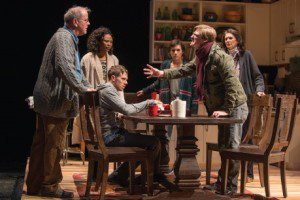NY Theaters Install Hearing Loops
Hearing Loops: Theater Industry’s Interest Showcases Opportunities
By Linda S. Remensnyder, AuD
The Nederlander Organization, which operates nine Broadway theaters in New York, recently installed hearing loops at its Richard Rodgers Theatre and Gershwin Theatre.
In Lincolnshire, IL, the Marriott Theatre became the state’s first musical Equity theater to have an induction hearing loop. At this theater-in-the-round, people with hearing loss are unable to supplement auditory information with visual cues for three-quarters of the performance.
The success of the Marriott’s loop has had a domino effect for future installations.
One example is Chicago’s Steppenwolf Theatre Company, which had a temporary loop installed this winter.
INDIVIDUAL VS BOUNDARY MICROPHONES
In March, Hearing Loss Association of America (HLAA) hearing loop advocate Juliëtte Sterkens, AuD; Marriott Theater business manager Margaret Newton; and I gave a presentation on induction hearing loops at a theater production managers meeting in Milwaukee, WI.
Dr. Sterkens was summoned by Michael Broh, production manager for American Players Theater outside Spring Green, WI, who stated, “I have noticed that amongst a nationwide group of theatrical production managers there has been an intense interest in exploring hearing loops for their own theaters.”
I then gave a follow-up seminar in a local library’s looped auditorium. (Libraries have federal Library Services and Technology Act funding available that can be tapped for hearing loops in your communities.) Evan Hatfield, director of audience experience for Steppenwolf, attended the seminar. Chicago theaters are a magnet both for suburban visitors and for national and international tourists.
Steppenwolf installed an initial temporary loop for a play already in progress using two shotgun microphones that provided the sound feed for the theater’s FM assistive listening devices.
Since the microphones were aimed at the stage from the back of the balcony—some 35 to 45 feet from the actors—the shotgun microphones failed to provide the necessary audibility enhancement required for people with hearing loss.
The next Steppenwolf play was Tribes by Nina Raine, which is about a deaf man, Billy, who finds himself at odds with his hearing family after his girlfriend, Sylvia, introduces him to deaf culture.
For Tribes, a second temporary loop was installed. It incorporated multiple and more sophisticated boundary microphones placed at strategic positions on the stage periphery, proving to be far superior to the shotgun microphone approach used initially.
Steppenwolf attendees, including cochlear implant users, confirmed that the second loop’s presence enhanced their theater experience, especially when the loop was supplemented by captioning or sign language interpreters. However, the boundary microphone method did not provide the same “wow effect” routinely experienced by telecoil-enabled listeners in looped venues where individual microphones are the norm.
Dramatic theater has numerous reasons, aesthetic and otherwise, for usually not providing a microphone on each performer. If Steppenwolf proceeds with a permanent loop, which is conceivable within the next year, the theater will notify patrons that it might be a different looped experience.
As technology is explored to provide superior amplification that satisfies audience needs, challenges like this will occur. See the innovative sound amplification methods Les Misérables director Tom Hooper undertook for his film: bit.ly/LesMisSound.
PATIENTS ADVOCATE FOR LOOPS
Despite these growing pains that all looping advocates encounter at one time or another, I wonder if audiology’s high attrition of doctoral candidates and current practitioners
For Steppenwolf Theatre Company’s production of (Windmill IM, Freeman BA: J Am Acad Audiol 2013;24[5]:407-416) reflects the fact that audiologists are not taught how critical these tools are to the future of our profession and to our own job satisfaction.
Performing diagnostic testing and programming hearing aids can become routine very quickly. Changing the quality of life for a person with hearing loss translates into long-term professional fulfillment, inspiring and motivating audiologists to find other means of enhancing their patients’ ability to cope.
As I educated my patients about induction hearing loops, frustrations about hearing in challenging listening environments shifted from the hearing aid to the environment.
My patients became vocal advocates for induction loops, and loops were installed in houses of worship, senior citizen gathering rooms, library auditoriums, government offices, and theaters, as well as in living rooms and bedrooms for enhanced television reception.
Hearing loops became a legacy, with some families requesting loop installation in memory of their loved one, rather than flowers or other charitable donations.
Other patients wrote the checks for installation themselves. Looped venues, such as houses of worship, started to advertise loop presence to differentiate their outreach in the community.
Hearing loops have constituted a wonderful boost to my patients’ quality of life and to mine as the “patient-centric” manager of their hearing loss, actively pursuing means of enhancing audibility in listening environments specific to them.
As I struggled to find funds for larger loop installations, such as for the local five-screen Landmark Theatre Renaissance Place Cinema in Highland Park, IL, my practice, Hearing Associates, approached two audiologists from other local practices—Paul Pessis, AuD, of North Shore Audio–Vestibular Lab, and Ronna Fisher, AuD, of Hearing Health Center—in conjunction with Highland Park Mayor Nancy Rodkin Rotering and the city’s Office of Economic Development.
Together, we made the cinema’s loop installation a community collaboration. The theater’s acknowledgement of the effort is prominently placed on the movie screen prior to the coming attractions for each film shown in any of the five theaters.
The screen display reinforces the fact that audiologists provide a holistic method of hearing loss management, and it inspires questions about looping. Landmark Theatres expanded its cinema loop presence to the newly renovated seven-screen Embarcadero Center Cinema in San Francisco.
HELP FOR CHALLENGING ENVIRONMENTS
When asked on then Brain Series with Charlie Rose why people don’t address their hearing loss, Ruth Bentler, PhD, of the University of Iowa, said that she believes vanity and financial constraints are secondary motives (bit.ly/BrainSeries). The overriding reason, Dr. Bentler said, is that hearing aids fail them in the challenging environments that cause the most distress.
People who seek hearing aids want them to help in background noise—in adverse listening environments with poor acoustics. Induction hearing loops do that, and they do it beautifully.
The Hearing Journal March 2014
Leave a reply

